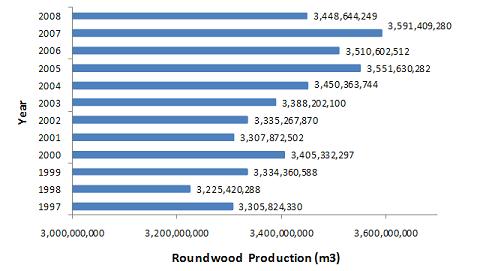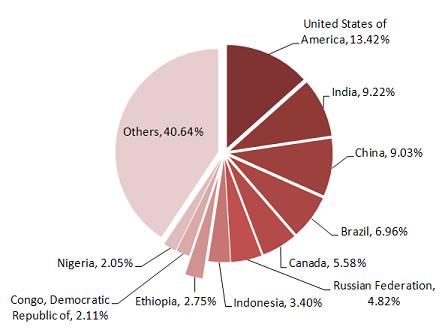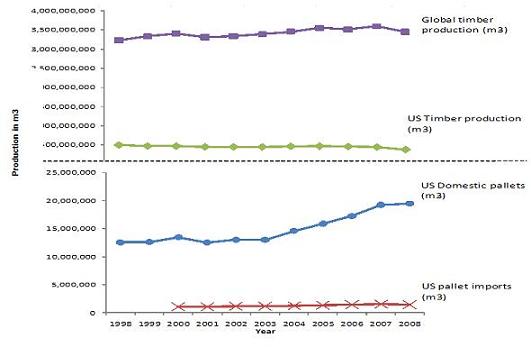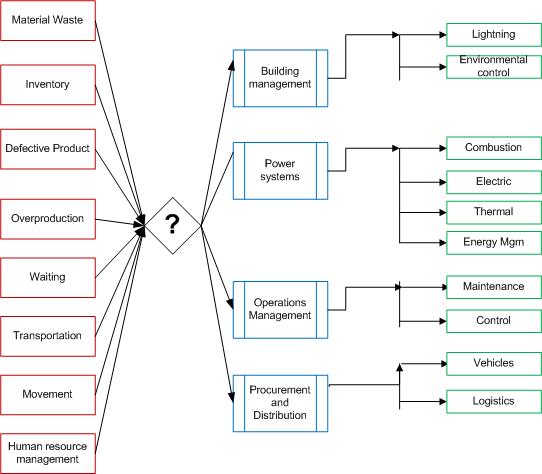The use of wood pallets is expected to grow, therefore; the sourcing of wood materials for pallet manufacturing requires attention. It is believed that wood pallet manufacturers will face increasing competition for raw materials from producers of wood-based composites, paper and paperboard, and biomass-based energy. Part of our research at VT is focused on identifying suppliers of wood pallet materials, meaning if they are domestic and/or imported. And going a little far, we would like to identify new possible sources of raw material, due to the increasing competition in the acquisition of wood pallet materials. An overview of roundwood production from 1997 to 2008 and main producer countries is presented in this research brief.
Roundwood production
Roundwood production is divided in two types: Hardwood and Softwoods. Figure 1 shows the respective quantities for each one and their respective trends through 1997 and 2008 in the United States. It can be seen that there is a decrease over the years for hardwood production. However, softwood production is increasing since 2002 until 2005, and decreases through 2008.
It is also important to identify the amount of roundwood in the World as shown in Figure 2. Similar to Figure 1, it shows an increase in roundwood production.
Figure 3 shows the production of roundwood of the 10 ten most important country producers by volume and their share respect to total production.
Comparison between Global and U.S Timber.
For our research it is also important to identify information regarding domestic pallet production, global imports of pallets, and also, in order to know the state of timber stocks and production in all countries, data about the global and U.S. timber production was collected. This information is shown and compared in Figure 4.
Table 1 contains the data depicted in Figure 4. It can be seen that global timber production is slightly increasing over the decade of analysis, from 3.2 billion m3 in 1998 to 3.6 billion m3 in 2007. On the other hand, the timber production in the U.S. had decreased during the same time span. U.S. timber production represents approximately 13.5% of the global timber output. Domestic pallet production in the U.S. shows a significant increase from 2003 and 2008 years, of about 35%. Pallet imports to the U.S. have also increased, although to a much lower rate than domestic production, approximately 25 %. Imports represent 8.7% of the domestic pallet production in the U.S.
Table 1. Pallets and Timber Production in the US and World (FAO, 2010; U.S. Census Bureau, 2010)
References:
- FAO. (2010). FAO Statistics-US Hardwood and Softwood Roundwood Production. Retrieved January 2010, from http://faostat.fao.org/site/626/default.aspx#ancor
- FAO. (2010). FAO Statistics-Global Roundwood Production. Retrieved January 2010, from http://faostat.fao.org/site/626/default.aspx#ancor
- U.S. Census Bureau. (2010). Annual Survey of Manufacturers – Wood Pallet and Container Value of Shipment, Years 2000 to 2008. Retrieved January 2010, from Department of Commerce – Census Bureau: http://www.census.gov/manufacturing/asm/
- U.S. Census Bureau. (2010, January 2010). Foreign Trade – Imports, Years 2000 to 2008. Retrieved January 2010, from http://www.census.gov/foreign-trade/







